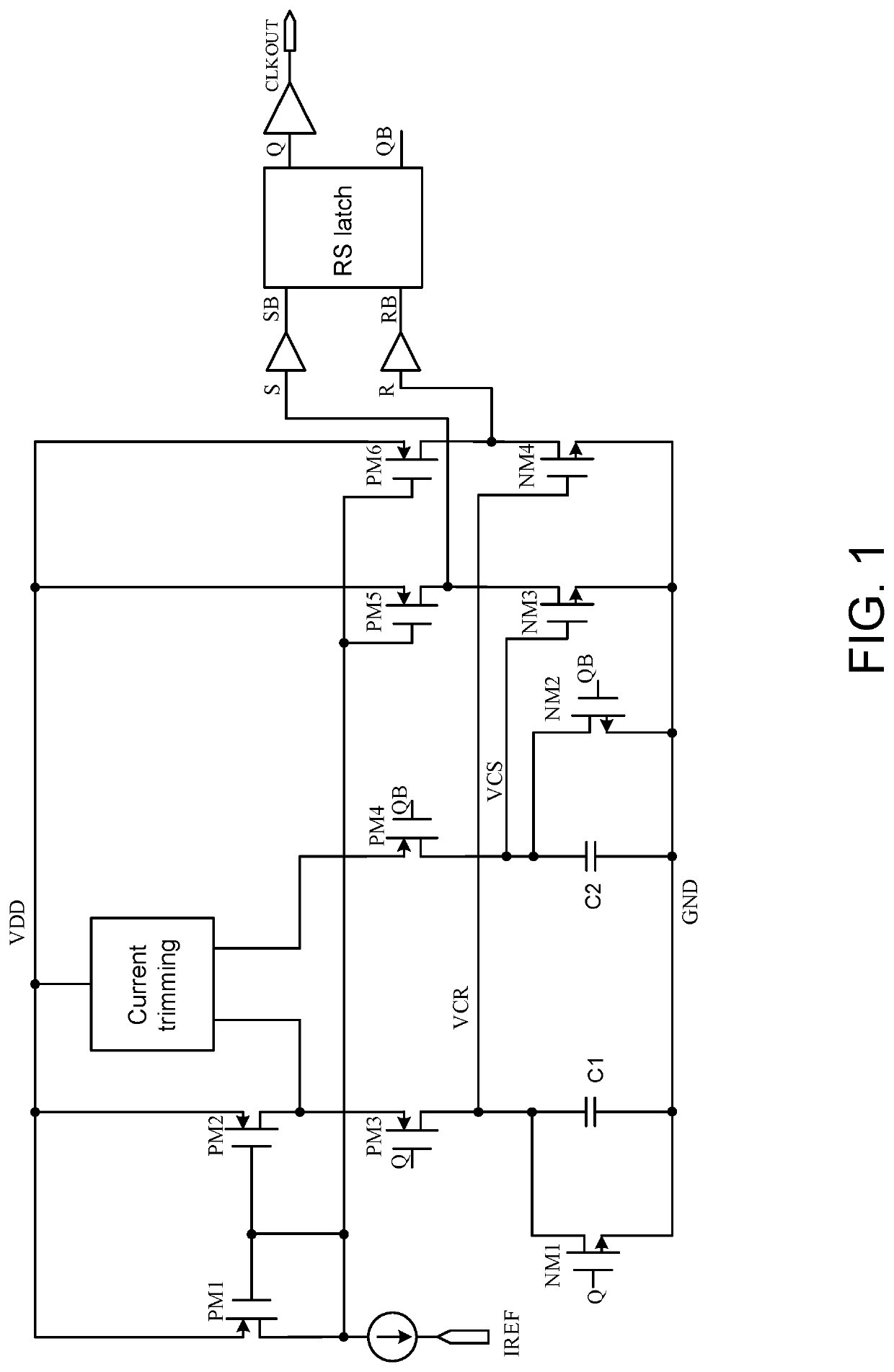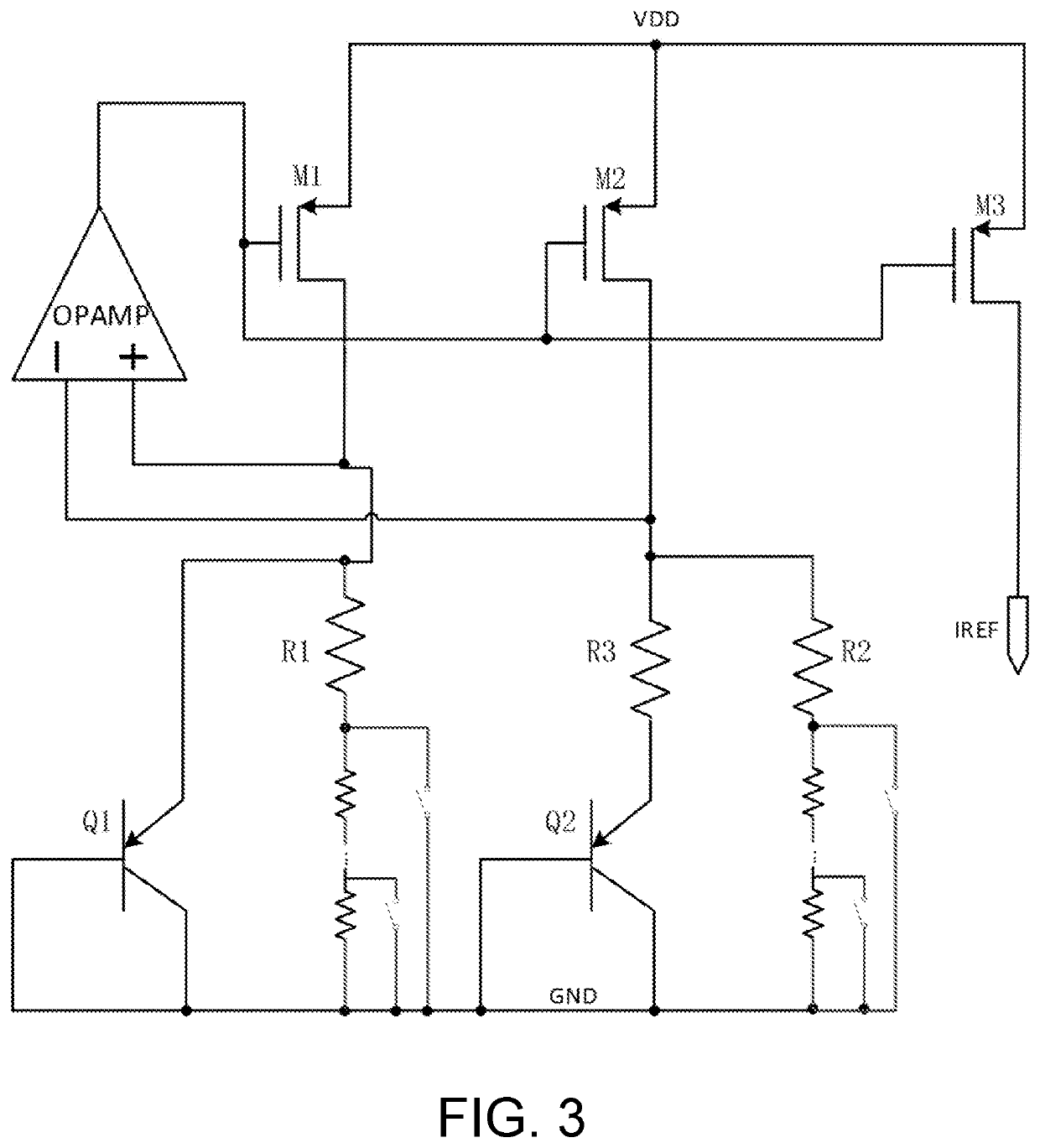Oscillator
a technology of oscillator and oscillator circuit, which is applied in the direction of oscillator generator, pulse generator, pulse technique, etc., can solve the problems of delay, frequency precision is still affected by other external factors, and the frequency precision of the common rc oscillator circuit is mainly limited, so as to reduce the effect of temperature and less dependency on power supply
- Summary
- Abstract
- Description
- Claims
- Application Information
AI Technical Summary
Benefits of technology
Problems solved by technology
Method used
Image
Examples
embodiment 1
[0043]As shown in FIG. 2, an oscillator comprises an RC oscillator 10 and a bandgap reference source 30.
[0044]The bandgap reference source 30 provides a reference current IREF for the RC oscillator 10.
[0045]A temperature coefficient of the reference current output by the bandgap reference source 30 is adjustable.
[0046]Preferably, the temperature coefficient of the reference current output by the bandgap reference source 30 is opposite to a temperature coefficient of an oscillation frequency output by the RC oscillator 10.
[0047]Preferably, both the RC oscillator 10 and the bandgap reference source 30 are semiconductor devices manufactured by mean of a CMOS process.
[0048]Preferably, the RC oscillator 10 and the bandgap reference source 30 are on the same substrate.
[0049]In the oscillator of embodiment 1, the RC oscillator 10 is selected as a frequency generating module, and since the oscillation frequency of the RC oscillator 10 has less dependency on a power supply, a clock source ha...
embodiment 2
[0050]Based on the oscillator of embodiment 1, as shown in FIG. 3, the bandgap reference source 30 comprises an operational amplifier OPAMP, a first PMOS transistor M1, a second PMOS transistor M2, a third PMOS transistor M3, a first PNP transistor Q1, a second PNP transistor Q2, a first resistor R1, a second resistor R2, and a third resistor R3.
[0051]The resistances of the first resistor R1 and the second resistor R2 are adjustable.
[0052]An output of the operational amplifier OPAMP is connected to gates of the first PMOS transistor M1, the second PMOS transistor M2, and the third PMOS transistor M3.
[0053]Source terminals of the first PMOS transistor M1, the second PMOS transistor M2, and the third PMOS transistor M3 are connected to a working voltage VDD.
[0054]A drain terminal of the first PMOS transistor M1 and an emitter of the first PNP transistor Q1 are connected to a positive input end of the operational amplifier OPAMP.
[0055]The first resistor R1 is connected between the posi...
embodiment 3
[0065]Based on embodiment 1, the oscillator further comprises a low dropout linear regulator 20.
[0066]The low dropout linear regulator 20 provides a working voltage source for the RC oscillator 10 and the bandgap reference source 30.
[0067]Preferably, the bandgap reference source 30 further provides the reference current IREF and a reference voltage VREF for the low dropout linear regulator 20.
[0068]The low dropout linear regulator (LDO) is a micro-power low dropout linear regulator that generally has extremely low self-noise and a relatively high power supply rejection ratio (PSRR). The low dropout linear regulator is a new generation of an integrated circuit regulator and differs from a three terminal regulator mainly in that the low dropout linear regulator is a system on chip (SOC) with very low self-consumption, which can be used for controlling a main channel of a current, with the chip being integrated with a MOSFET with extremely low on-resistance and hardware circuits such a...
PUM
 Login to View More
Login to View More Abstract
Description
Claims
Application Information
 Login to View More
Login to View More - R&D
- Intellectual Property
- Life Sciences
- Materials
- Tech Scout
- Unparalleled Data Quality
- Higher Quality Content
- 60% Fewer Hallucinations
Browse by: Latest US Patents, China's latest patents, Technical Efficacy Thesaurus, Application Domain, Technology Topic, Popular Technical Reports.
© 2025 PatSnap. All rights reserved.Legal|Privacy policy|Modern Slavery Act Transparency Statement|Sitemap|About US| Contact US: help@patsnap.com



